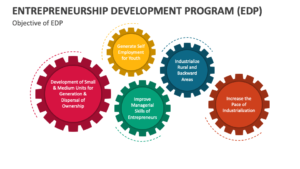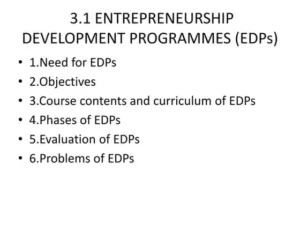Objective of Entrepreneurship Development Program (EDP)
In order for any economy to grow, entrepreneurship is essential. Innovation, the creation of jobs, and general economic growth are all fueled by entrepreneurs. However, it’s crucial to offer the proper kind of assistance and direction in order to encourage the spirit of entrepreneurship. Entrepreneurship Development Programs (EDPs) are useful in this situation.
What is an EDP?
An Entrepreneurship Development Program (EDP) is an organized training program created to help people gain the abilities and information required to launch and run their own company. EDPs are designed to foster an entrepreneurial mentality and assist prospective business owners in overcoming the obstacles associated with starting and expanding their enterprises.

Key Objectives of an EDP:
1. Promoting Entrepreneurial Spirit:
The principal aim of EDP is to motivate and inspire people to embark on entrepreneurial endeavors. This entails giving them self-assurance and allaying their concerns about launching their own company.
2. Skill Development:
EDPs concentrate on improving managerial and practical abilities like communication, marketing, financial management, and problem-solving. Entrepreneurs acquire the skills necessary to manage a variety of business activities efficiently.
3. Providing Knowledge of Business Environment:
For a firm to succeed, it is essential to comprehend the market dynamics, competition, and client wants. The goal of EDPs is to teach participants how to evaluate market conditions and make the most of this information.
4. Identifying Opportunities:
EDPs aid participants in conducting market research, evaluating risks, and determining the viability of their business ideas, and they assist entrepreneurs in identifying promising business prospects based on regional or worldwide trends.
5. Resource Mobilization:
Finding sufficient capital is a common challenge for aspiring business owners. EDPs offer advice on how to locate financial resources, communicate with investors or financial organizations, and efficiently handle money.
6. Building Confidence and Overcoming Fear:
Fear of failing is one of the biggest obstacles faced by aspiring business owners. By assisting participants in realizing their potential and overcoming obstacles, EDPs aim to increase self-confidence.
7. Creating a Support System:
EDPs provide a network of mentors, fellow entrepreneurs, and industry experts that may offer invaluable guidance and support during the entrepreneurial journey.
8. Creating Job Opportunities:
By cultivating a new generation of entrepreneurs, EDPs indirectly facilitate employment creation, both directly (via the new enterprises they establish) and indirectly (via the products and services they provide).
9. Encouraging Innovation:
EDPs encourage participants to think creatively and innovatively. By fostering an innovative mindset, they contribute to the development of new products, services, and business models.
10. Sustaining Long-Term Growth:
EDPs not only concentrate on initiating enterprises; they assist entrepreneurs in formulating plans for enduring growth, encompassing operational scaling, efficient resource management, and maneuvering through hurdles in a swiftly evolving market.

Conclusion:
The primary aim of EDPs is to cultivate a more resilient entrepreneurial ecosystem by delivering appropriate information, resources, and assistance. Through targeted training and guidance, aspiring entrepreneurs gain the skills necessary to succeed and contribute meaningfully to the economy. By achieving these goals, EDPs help unlock the potential of individuals and create a foundation for sustainable business development.